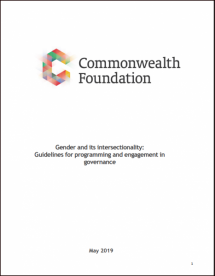Gender and its Intersectionality: Guidelines for Programming and Engagement in Governance
The Commonwealth Foundation sets policy guidelines for all countries within the British Commonwealth. This document provides an understanding of intersectionality and its application to the Foundation’s focus in supporting people’s participation in governance.
It offers key questions for the Foundation to consider when planning a project, and offers guidance in developing policy and practices.
Source: Commonwealth Foundation
Date of Publication: March 15, 2021
SIMILIAR RESOURCES
Tools
Examples
- What Does it Mean to Leave No One Behind? A United Nations Development Programme Discussion Paper and Framework for Implementation
- Intersectionality 101
- Intersecting inequalities: Gender Equality Index
- 10 Best Resources on Intersectionality with an Emphasis on Low- and Middle-Income Countries
- Guidance on Social and Behavior Change for Family Planning During COVID-19
- What is Intersectionality?
- Kimberlé Crenshaw: What is Intersectionality?
- How Businesses Can Invest in Women and Realize Returns
- Template for Stakeholder Engagement Plan
- La Planification Familiale dans les Situations d'Urgence: Essentielle,, Voulue, Necessaire et Realisable




